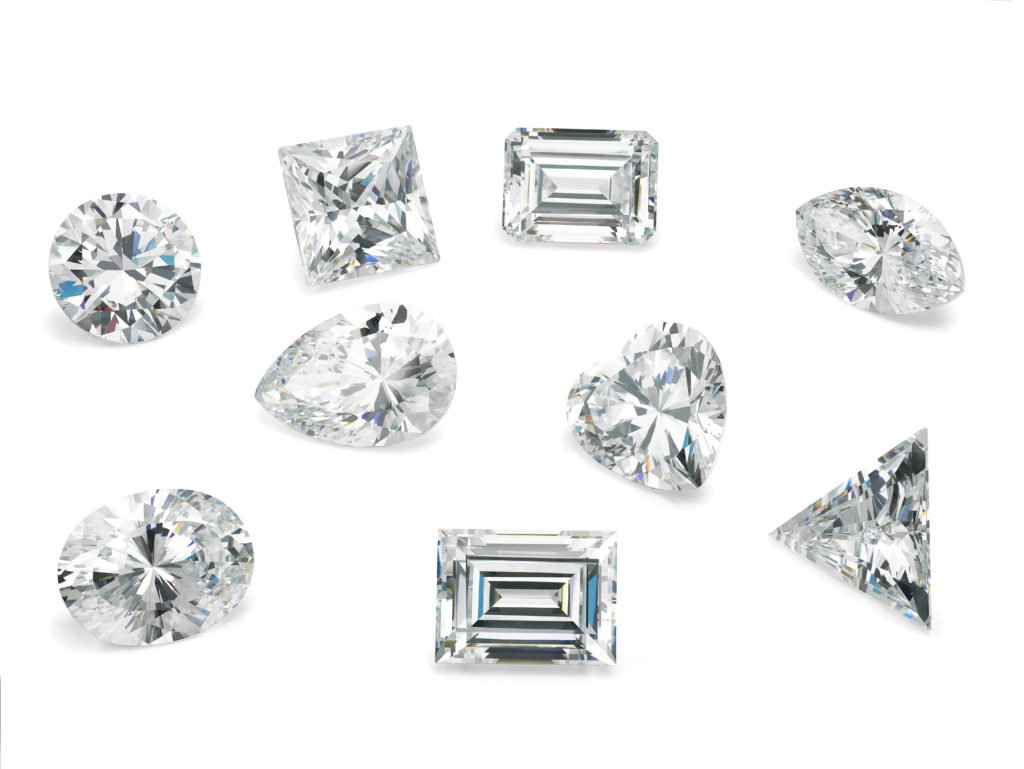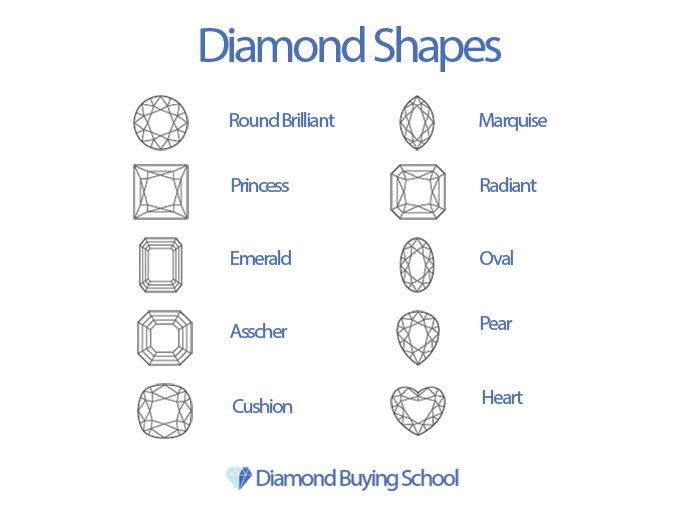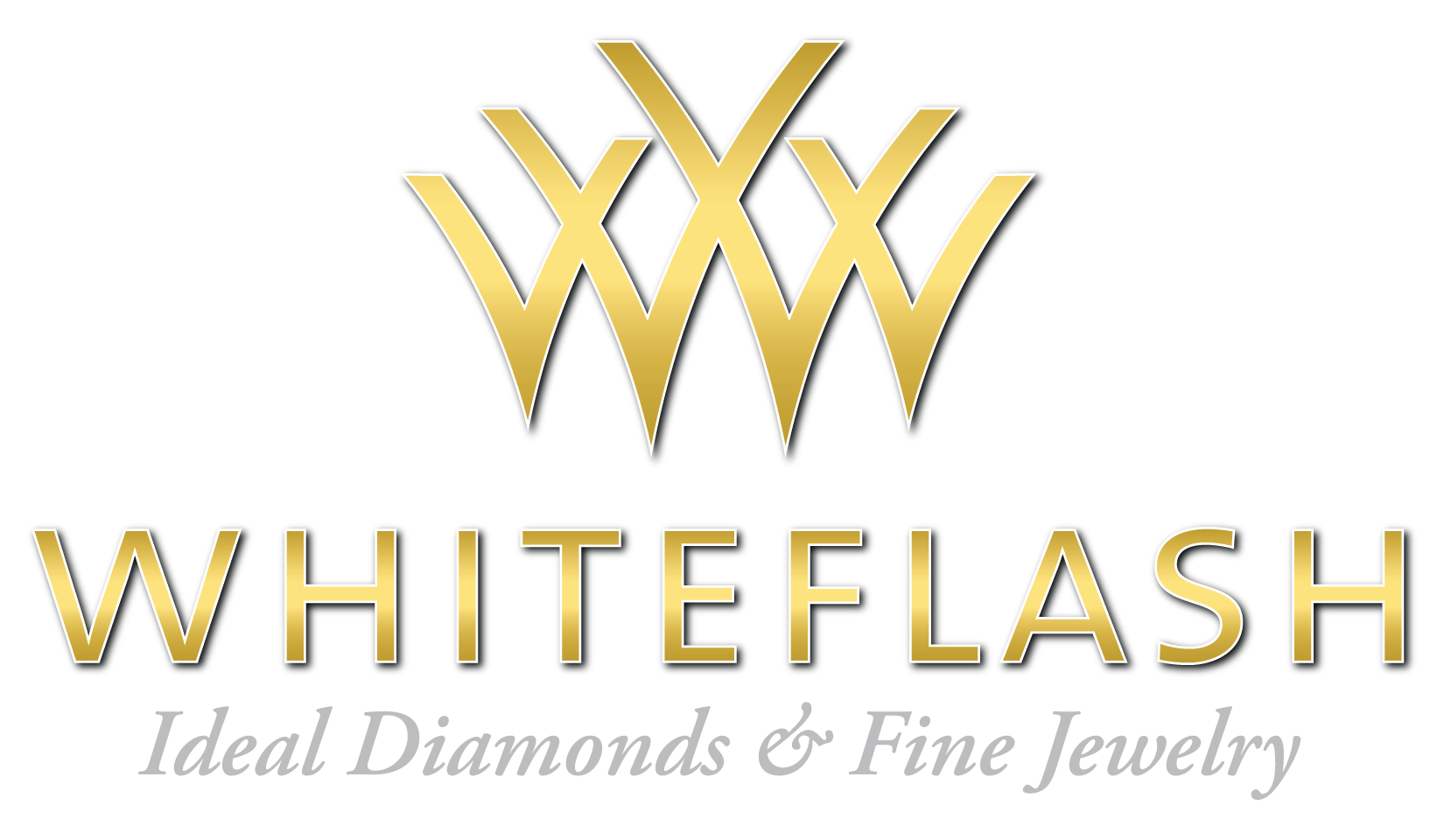Diamond Shapes Compared
There are 10 common diamond shapes you can buy. Round-cut diamonds (also known as brilliant-cut) remain the most popular and expensive. The other shapes (known as fancy cuts) offer something for everyone. Let’s take a look at what some diamond cut studies have to say about the different types or cuts of diamonds that you can purchase.

Types of diamond shapes
Most diamonds sold are cut into one of 10 shapes: Round, princess, emerald, Aa, cushion, marquise, radiant, oval, pear and heart. The diamond ring shape that you get is going to depend on what exactly you are looking for in terms of brilliance, price, quality, and more.
Although the tradition of wearing a diamond as an engagement or wedding ring is a practice that is now over 530 years old, it was only a little over a century ago that a Russian mathematician carefully calculated the number of exact cuts it would require to achieve an “ideal” diamond shape, which is known is a brilliant cut diamond. This would imply that any finished form of a diamond, especially the earliest form, was nothing close to the amazing cuts that we have now. As you can see, the history of diamond cuts, as far as modern cuts go, is not all that long.
Diamond cutters of today have advanced equipment and techniques they use to achieve an ideal cut to intensify the sparkle of a diamond. This allows diamond makers to achieve the highest diamond cut grading standards possible.

Round (brilliant)
As you just learned, the Round Diamond (also known as the brilliant cut) continues to be the most popular choice. When cut properly, its 58 facets will bring out the very best features of the diamond, including fire and scintillation. Some specialty cuts have more than 58 cuts to further enhance the round brilliance. Many of these specialty cuts feature a hearts and arrows pattern that can be seen through a special gemscope. The number of facets vary depending on the diamond manufacturer, but 58 facets is widely accepted as the minimum number of cuts required to achieve an optimum round diamond to be worn as jewelry.
As far as facet diamonds go, this is of course one of the most difficult to create. This, combined with the fact that you will often find the brilliant cut in combination with a flawless diamond, does make it one of the more expensive options out there.
Princess
For those who like “square” diamonds, the princess cut is what you should be looking for. Princess cut diamonds can be more forgiving in hiding any inclusions of a diamond because they can also be designed for maximum brilliance. To be safe, the princess cut diamond should be set in at least a four prong setting to be safe for wearing every day.
As far as engagement ring trends go, using the princess cut diamond has become quite popular.
Emerald
No, it’s not a green diamond. An emerald cut refers to a shape that was originally designed to best showcase emerald gemstones and this has become a rather common form to cut diamonds to. Its gradual stepped rectangular shape uses fewer facets, which can take away from the brilliance of the diamond in certain settings. So, instead of constant sparkle, an emerald cut diamond might give you dramatic light flashes when combined with a nice setting that enables light to capture the diamond. High settings can work well with emerald cut diamonds and possess sophistication and elegance.
Asscher
The Asscher cut diamond has made a comeback since its original introduction by the Asscher Brothers of Holland back in 1902. The “stepped square” cut can best be described as a cross between a princess and emerald cut diamond. Until recently, the Asscher cut was not commonly found in modern diamond stores and was more of an heirloom piece from estate jewelry collections that have been around since the mid-16th century or longer. However, its recent resurgence can be attributed to an appearance on the popular “Sex in the City” TV series and through a few celebrities who have chosen this cut for engagement rings. If you’re a fashionista, the Asscher cut is for you!
Cushion
Much like the Asscher diamond, the cushion diamond shape were almost nonexistent in modern jewelry stores and could only be found at estate auctions or as heirlooms. This antique cut is also known as a “Miner’s cut”, which has a trademark of large facets that were a result of less advanced technology of diamond cutters back at the turn of the twentieth century. To look at a cushion cut, to some it might look like an oval, while to others it might seem to have an elongated rectangular shape with rounded corners. Both are indicative of a cushion cut because of its undependable sizes, depth and variables used to make it.
Also, having fewer facets means it has less sparkle than other diamond shapes which means that its optical performance isn’t as high as with some of the other diamond cuts, as having fewer facets does lead to a slight loss of brilliance. But for people searching for something totally “unique” or that resembles a sentimental heirloom in their families, the cushion cut just may become a favorite.
Marquise
A marquise shaped diamond can be best described as having a shape of a kayak, with two pointy ends and a wide middle. The marquise cut diamond is quite unreliable and can be long and narrow or thick through the middle, depending on how it is made. Marquise diamonds work well to hide undesirable characteristics of the diamond since they require a fancier setting than many other types. However, when the marquise is cut right, it provides an unusual and wonderful effect; picking up much light from every angle, therefore, offering great light performance, particularly in white light. The optical brilliance of this cut of diamond ring is one of the highest out there at this time.
Radiant
One of the newer choices to consumers is a cross between the favorite round brilliant diamond and a less common Asscher or Emerald cut. The latter two have less sparkle and brilliance than a round; however the radiant cut was specifically designed for maximum fire. This is one of those diamonds you can’t miss because it catches the light so well and does a great job at hiding any undesirable characteristics of a diamond. The intense sparkle that it features makes it a true one of a kind diamond cut to consider. Its uniqueness makes the radiant cut diamond very special, indeed.
Oval
An oval diamond can have almost as much brilliance as a round diamond. Its egg shape appears larger than a typical round diamond, while still offering plenty of sparkle. Some oval diamonds are long and narrow, while others are wider and stout, so it’s important to look at the certification to check the length to width ratio. They may also need to be set in six-prong or bezel settings to secure the larger oval shape of the diamond. This fairly modern shape that features rotational symmetry was introduced in the early 60’s as an oblique variation of the more commonly found brilliant round.
Pear
Bring a “tear” to her eye with a pear shaped diamond. It’s also known as a teardrop diamond because the shape is a cross between a round and a marquise shape. One side is rounded, while the opposite side is pointy , therefore, achieving the actual shape of a pear.The pear is a tough diamond shape to cut and if done poorly, can lead to less sparkle or unevenness that diminishes its value. When cut right, the pear shape can be a tantalizing choice.
The asymmetric outlines that this cut of diamond features makes it look like none other. What is also important to note is that the pear cut diamond also happens to be one of the most affordable diamond shapes out there. This is interesting because although it is not an expensive diamond shape, the diamond cutting process required to create it can be rather difficult.
Heart
A heart shaped diamond is undoubtedly a romantic choice. The name of this cut speaks for itself, being crafted in the shape of a heart. Considered a “fancy” shape diamond, the complications in cutting require an artful skill of a master cutter. They look a bit like a pear shaped diamond, yet with a small cleft at the top. It can be tough to find a large heart diamond due to its less-asked for demand in the marketplace and often higher price for cutting. Although not the most popular choice in the world, as far as modified forms go, this is a very unique one, and it can have some great internal brilliance to it.
Which diamond shape is best?
Round diamonds (also known as brilliant-cut diamonds) are the most popular shape and, arguably, sparkle the most.
That said, each diamond shape is beautiful in its own way. And just choosing the diamond shape will mean very little if it is not a quality gem and set in an appropriate setting.
The setting is the piece of jewelry that showcases the diamond. There are many types; from prong-style to bezel, tension settings, channel, bar and more. Some people mistakenly choose a setting for their diamond based only on preference for the style, without considering whether it will provide the optimum ability for light to enter in and flow out through the facets of the diamond.
For example, trying to display a radiant cut diamond in a low setting (like bezel or channel) is a wasteful way to lose sparkle, since the light will not be able to enter easily through the bottom and top to capture all of the fire and brilliance that is intended of the radiant cut. It’s the angle of incidence that needs to be considered.
Explore these things when weighing which type of diamond you will choose. The Diamond Buying School is here to provide expert advice, but make sure when you are shopping for a diamond to ask your jeweler for an honest perspective on the best setting for each shape you are considering. Sure, a classic outline might look ideal for some cuts, but there are times when a more modern approach is called for.
The diamond cut is the shape in which the jeweler (aka – the diamond cutter) chooses as the best way to showcase the diamond to reflect its best features. Since less than 1% of the world’s diamonds are worthy of being made into a wearable piece of jewelry, the choice is a determination made early within the discovery process.
The diamond manufacturer takes the rough stone and cuts it into a faceted gemstone, which requires highly skilled equipment, tools, aptitude and knowledge. The diamond maker assesses not only the karat weight of the diamond and its internal or external inclusions; he must also bear in mind the demand for specific shapes within the marketplace.
For example, round diamonds have always been the most desirable among consumers because their shape offers the most sparkle and brilliance when cut properly. Round diamonds are known for having the best overall symmetry.
How does diamond shape affect price?
Round or brilliant diamonds are by far the most popular diamond shape and — therefore — also the most expensive. Some fancy cut diamonds can cost as much as 25% less as a round diamond of similar quality.
This chart developed by Blue Nile shows how diamond shape can affect price.
Among a sampling of 1-carat diamonds with similar cut quality, clarity, and color grades, the round diamond was the most expensive at $2,556. The Emerald diamond was least expensive, costing $1,742.
Some fancy shapes like oval, marquise, and pear diamond can appear larger than they are. If the appearance of a diamond’s size is important to you, these may represent the best value.
The most popular fancy shapes are princess, cushion and radiant, making this shapes closer in price to round diamonds.
What is interesting is that the difference in size of the diamond is going to make less difference in terms of the price than the quality of it, with flawless of course being the most sought-after option.
Recommended Jewelers
James Allen
James Allen is the most competitive diamond vendor with more than 150,000 loose diamonds in inventory. They have been a leader in selling diamonds online and pioneered 3D imaging so you can see the exact diamond you're buying in exquisite detail. You'll find it hard to beat James Allen in terms of price or selection. Read our James Allen review. |
Whiteflash
Whiteflash is the home of "A Cut Above" diamonds which are among the best quality round- and princess-cut diamonds in the world. With superior diamond photographs and videos, Whiteflash's diamonds seem to come to life -- even online. Read our Whiteflash review. Shop Whiteflash » |
Brilliant Earth
Brilliant Earth is the global leader in ethically-sourced jewelry. Brilliant Earth goes above and beyond existing standards to offer “Beyond Conflict Free Diamonds” that they select for their ethical and environmentally-responsible origins. With over 120,000 diamonds in inventory, you can be sure to find your perfect diamond and feel good knowing it was responsibly-sourced. Read our Brilliant Earth review. Shop Brilliant Earth » |
Blue Nile
Blue Nile is the world's largest online jeweler. Their reputation for quality and customer service is unparalleled in the industry. Blue Nile offers free shipping, a 30-day return policy and satisfaction guarantee. Read our Blue Nile review. Shop Blue Nile » |